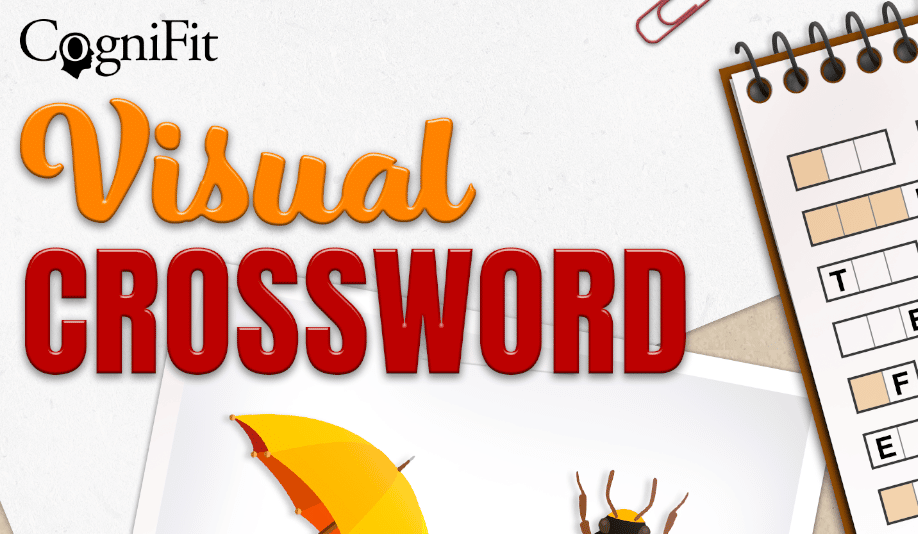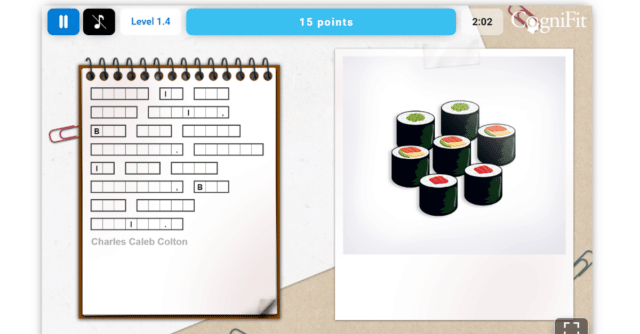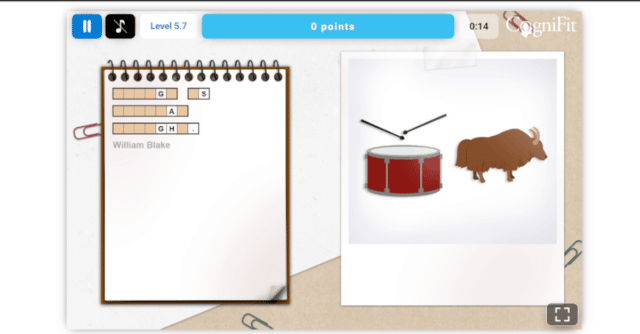
Visual Crossword Game – Quick Recollection with Images
Visual Crossword isn’t a traditional crossword. In any other version, you would sit at the kitchen table with a cup of coffee and hash out however much time you have until the demands of adulthood start calling. But CogniFit’s version (like all its other brain games) targets certain cognitive functions to help build brain plasticity.
Today, let’s take a look at how Visual Crossword works and what area of the brain it targets.
How To Play Visual Crossword
The first thing you’ll notice is that the string of boxes doesn’t intersect. Instead, they for strings of words that will (when complete reveal a quote by someone famous – something funny, motivational, or inspiring).
What you have to do is focus on the right side of the screen. You’ll get a flash of an image, and then it will disappear. Afterward, you’ll get four letters. You have to choose the first letter of that word. So, if you saw a violin, you would click “v” and so on.
There’s also a countdown clock that gives you time on lower levels but far less wiggle room on harder difficulties. And as levels increase, you’ll have more than one image to memorize and less time to click the letters.
And before you think this is a breeze. There are some images that will throw you for a loop. For example, there is one you would swear is a certain flower name but is an entirely different one. So, stay on your toes!

How Does Visual Crossword Help Your Brain?
1. Naming
Naming is our ability to refer to an object, person, place, concept, or idea by its proper name. This sounds simple, but it’s important to realize that for us to do this we have to access our internal dictionaries containing tens of thousands of words and pull up these words on demand. Then we have to use our verbal functions to say them out loud.
- Phase 1 (the semantic system): Recovering information about the object that you want to name. For example, if you see an old classmate on the street, you identify that he was a classmate, that he was in your x class, and that he was friends with John, Tim, and Bill.
- Phase 2 (phonological lexical system): Recovering the best word for the object or idea. Using the same example, your old classmate’s name was Jeff, which would make it the most appropriate name to call him. This is the key process in Naming.
- Phase 3 (phoneme storage): Recovering each of the phonemes that make up the chosen word. For example, Jeff would be “/j/, /e/, /f/”.
These three phases are independent, which means that one of them can be altered without affecting the others. As such, the ability to remember a specific word is unrelated to the information that you have about the object that you want to name.
There are also other disorders where Naming is affected, like Alzheimer’s Disorder, Specific Language Impairment, or semantic dementia.
2. Visual Perception
This brain function lets us make sense of what we see. Reading these words might seem easy. But for someone with dyslexia, it’s not such an easy process. It all starts with the eyes…
- Photo-reception: The light rays reach our pupils and activate the receptor cells in the retina.
- Transmission and basic processing: The signals go through the optic chiasma (where the optic nerves cross, making the information received from the right field of vision go to the left hemisphere, and information received from the left field of vision go to the right hemisphere), and it then goes to the lateral geniculate nucleus of the thalamus.
- Break Down and Recognition: Finally, the visual information that our eyes receive goes to different parts of the brain so it can break the object down into things like size, shape, color, distance, position, lighting, use, etc. (and this is if you already know what the object is!)

3. Working Memory
Ah, memory. Probably the one thing most of us wish we would improve. But did you know there are different kinds?
Also called “operative memory” it’s a set of processes that allow us to store and manipulate temporary information and do complex cognitive tasks like language comprehension, reading, learning, or reasoning. It’s also a kind of short-term memory.
Definition of working memory according to the Baddley and Hitch model
Working memory, according to Baddley and Hitch, is made up of three systems, which include components for information storage and processing.
- The central executive system: Works like an attention supervision system that decides what we pay attention to and how to organize a sequence of operations that we will need to do to do an action.
- The phonological loop: Allows us to manage and retain spoken and written material in our memory.
- Visual-spatial agenda: Allows us to manage and retain visual information.
- Episodic Buffer: integrates information from the phonological loop, viso-spatial sketchpad, the long-term memory, and the perceptive entrance into a coherent sequence.
Visual Crossword Conclusion
Because all short-term memories are limited in capacity (and doorways for information to go into long-term memory), we can’t really nurture them to be something out of a movie; where anyone can remember literally anything. But we can give it a bit of a boost and learn tricks to make it easier. This is especially useful for anyone wanting to learn something new.
And the good news is, it doesn’t take countless hours. The sweet spot of brain training is three times a week and 20 minutes per session. Easy peasy.












